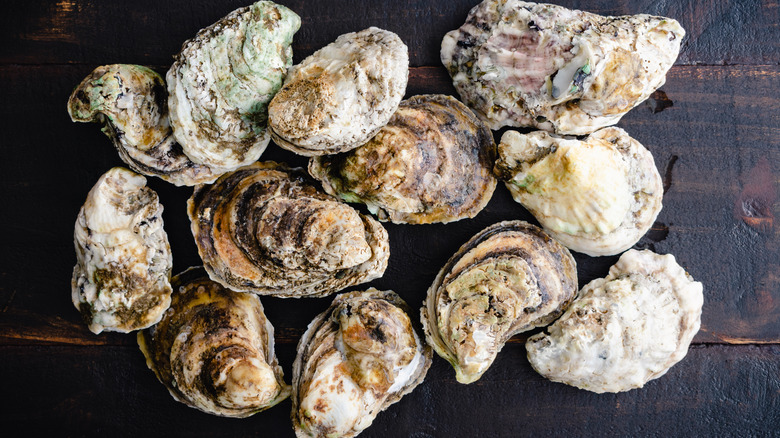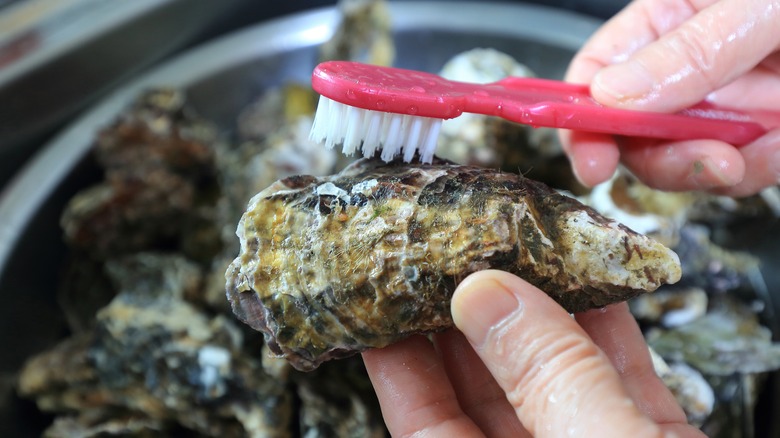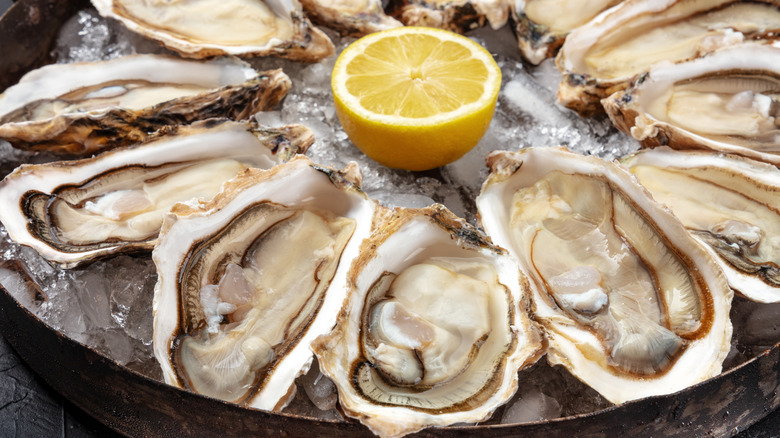The Biggest Mistake You Could Make While Storing Oysters
Oysters are sweet little gems of salty goodness. Serving them at a party, date night at home, or dinner for one can easily turn a good meal into something great. There is nothing quite like being presented with those glimmering silver-gray half-shells on a big platter of ice.
As with any raw seafood, it is important to keep oysters very cold when you store them to preserve freshness. Ice may come to mind as a way to do that. However, using ice for storage is a crucial error that can end up completely ruining your oyster dreams. That is because when you buy oysters, they are alive, and live animals need to eat. They do this by filtering water through their gills and extracting nutritious particles. However, oysters are ocean dwellers, so they live in saltwater — if a live oyster tries to filter freshwater, it will kill it. The ice that you store oysters in will eventually melt into unsalted water, so you run the risk of your mollusks kicking the bucket before you are ready to serve them.
How to clean oysters
You want the oysters you buy to stay alive until right before shucking. Keeping live oysters directly on ice is taking it one step too far, but you do need to keep them as cold as you can without harming them. Make sure you have a cooler ready to go on the way home from the seafood monger. Once you are back at your place, you can technically stash them without cleaning them first, but cleaning them prior saves you some mess in the long run.
Make sure that the shells are closed (or close quickly when tapped) and undamaged. A live oyster should smell salty and clean, and dead ones will have a notably foul smell. If any off-scents are coming from your batch, you should be able to use your nose to identify the culprits.
Scrub them under cold running water with a stiff and abrasive brush, but don't let them sit in freshwater — transfer them to a colander after scrubbing. Many store-bought oysters will not need purging, but wild oysters may have more debris inside. The process is similar to how to purge clams. Just place the oysters in a bowl of cold salted water, and keep the bowl in the fridge. Let them do their thing for about an hour — you may see some grit accumulate in the bottom of the bowl. Lift the oysters out of the water and allow them to drain in a colander.
How to store oysters
Line a rimmed baking sheet with a slightly wet cloth, arrange the cleaned oysters in one layer, and cover them with another damp towel. If you are pressed for space, a bowl covered with a damp cloth will also do the trick. When possible, keep the oyster with the rounded side of the shell facing down, so none of the oyster liquor leaks out. This helps keep the oysters alive and ensures they stay super tasty. Never store oysters in an airtight container or even a closed drawer because they need air circulation to survive. When stored properly, raw oysters will stay fresh for about one week after the time of harvest. Per Food and Drug Administration requirements, all live mollusks are sold with a tag indicating exactly when and where they were harvested.
Do a final pass to make sure they are all alive and well, and shuck oysters just before serving. Keeping them alive as long as possible decreases food safety risks and ensures they taste pristine. Once they are dead, ice poses no risk, and is perfect for keeping oysters on the half-shell deliciously cold. Arrange them on crushed ice either from blitzing cubed ice in the food processor or picking up a bag of nugget ice from your favorite fast food joint. Accompanied by acidic mignonette, fiery horseradish, or a simple squeeze of lemon, it will quickly become clear that oysters are well worth the effort.



